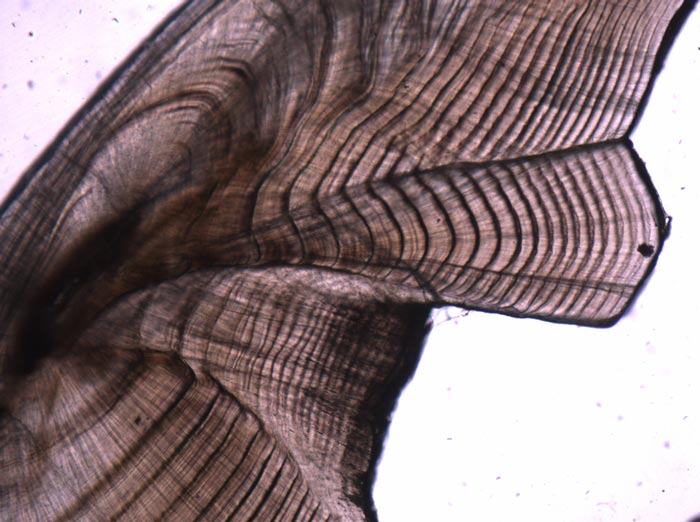

Image by Zoe Doubleday, University of Adelaide. Permission to use with this story only.
A sectioned ear bone of black bream showing its growth rings.
Published in the journal Biology Letters, University of Adelaide research has shown that within this single species of fish there are some individuals which migrate to different parts of the Coorong in South Australia, and some that generally stay in the one location. Black bream are important for recreational and commercial fishing.
“When we consider animal migration, we tend to think of large seasonal migrations of species like the humpback whale or the Arctic tern. We don’t often think of migratory behaviour that varies within populations,” says Professor Bronwyn Gillanders, from the University’s School of Biological Sciences and Environment Institute.
“But it appears that within the black bream Coorong population there is a ‘bet-hedging strategy’ that allows the fish to survive and persist in the Coorong over good times and bad.
“Migration to another area may be more favourable under drought conditions when the water becomes more saline and, conversely, when there is lots of fresh water coming in and there is lots of food readily available, it would be more beneficial for the fish to stay in the location. This probably helps to make the species more resistant to both climate and human-related change.”
The researchers used the ear bones of fish collected throughout the estuary to construct their findings. Fish ear bones provide much information through analysis of the trace elements they contain and the width of their growth rings.
“Like tree growth rings, the ear bones reveal the age of the fish and growth periods which correlate with the growth of the fish itself,” says Professor Gillanders. “When we measure the width of the growth increments, we can trace back to see how fast the fish was growing at a particular time and year.
“The bones can also tell us whether the fish is migratory or ‘resident’ by mapping the ratios of barium against calcium. The higher levels of barium indicate when the fish was in fresher water.”
Professor Gillanders found that 62% of the fish were resident and 38% were migratory. Models were used to investigate differences in annual growth between the two groups and construct a growth time series.
“Throughout the late 1990s and early 2000s resident fish had increased growth compared with migrant fish but this changed around 2005 when growth of migrant fish increases,” says Professor Gillanders. “This is likely to be a result of the deteriorating conditions in the Coorong and reflects the ability of the migratory fish to find more favourable conditions and source more food.”
This research was in collaboration with the South Australian Research and Development Institute (SARDI.
Media Contact:
Professor Bronwyn Gillanders
Southern Seas Ecology Laboratories
School of Biological Sciences and Environment Institute
The University of Adelaide
Phone: +61 8 8313 6235
Mobile: +61 417 036 235
bronwyn.gillanders@adelaide.edu.au
Robyn Mills
Media and Communications Officer
The University of Adelaide
Phone: +61 8 8313 6341
Mobile: +61 410 689 084
robyn.mills@adelaide.edu.au















